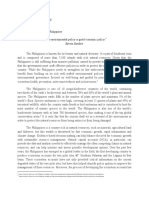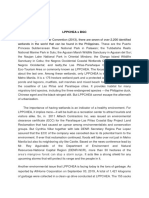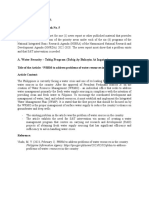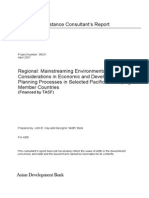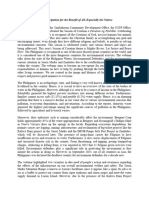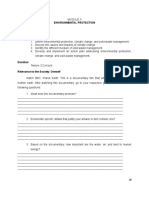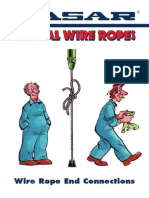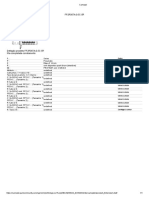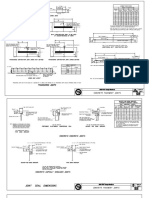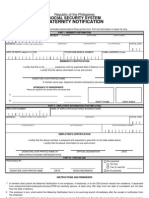23
2013 Ecological Footprint Report
Restoring Balance inLaguna Lake Region

Restoring Balance in Laguna Lake Region2013 Ecological Footprint ReportTable of Contents
Message from the President of the PhilippinesForeword
AusAIDGlobal Footprint Network
Laguna Lake Development Authority
Message from the Laguna Lake Development AuthorityThe Evolution of LLDA: A Strategic Response
Ecological Footprint, Biocapacity, and Overshoot
The Global Context
The Philippines
Key Findings
Laguna Lake Region
Four Decades of Ecological Change
Biocapacity of Laguna Lake Region
What is Biocapacity?How Much Can Laguna Lake Region Provide Per Person?
Ecological Footprint of Laguna Lake Region
What is the Ecological Footprint?The Global Hectare MetricOur Ecological Footprint The Consumption Land Use Matrix (CLUM)Ecological Footprint for Producing Things
Net Steps
Resource Limits in Policy
Appendi A.i.
Calculating the Ecological Footprint, Consumption, Production and Biocapacity
Appendi A.ii.
Multi-Regional Input-Output Analysis for the Ecological Footprint
Appendi A.iii.
Methods for calculating Biocapacity of LLDA Region
Acknowledgements01030919253141496367717577
Global Footprint Network U.S. Ofce
312 Clay Street, Suite 300Oakland, California 94607-3510 USA +1-510-839-8879www.footprintnetwork.org
Europe Ofces
Brussels, BelgiumGeneva, SwitzerlandThe cover and pages of this book were printed on 9lives Offset paper, which is manufactured from 100% recycled bre. It is FSC and ISO 14001 certied.
21
Message from the President
Benigno Simeon C. Aquino III
President, Republic of the PhilippinesChairperson, Climate Change Commission
34
Ecological constraints have become a signicant determinant of economic success in the 21st century. The trends of each component of the food-energy-climate nexus is amplied by their interconnection. Each country is affected by these trends, but not equally. It matters tremendously for each country how it prepares itself. Therefore, it is Global Footprint Network’s mission to help decision-makers to address this nexus so they can choose successful strategies. We do this by offering decision-tools that incorporate the reality of ecological limits. We want these tools to support countries in making their policies and investments most effective in this new era of ecological constraints.I am particularly thrilled with the Philippines’ commitment to sustainable development. With the leadership of the Ofce of the President’s Climate Change Commission and the French Agency for Development, in 2012 the Philippines became the rst Southeast Asian country to adopt the Ecological Footprint. Phase I, documented in “A Measure for Resilience: 2012 Report on the Ecological Footprint of the Philippines”, laid the foundation for ecological resource accounting in the Philippines. With support from AusAID in collaboration with the Laguna Lake Development Authority, this 2013 report delineates Phase II, an in-depth look at resource availability and consumption patterns for the Laguna Lake region. Not only does this region encompass the nation’s economic epicentre, Metro Manila, it also houses the most vulnerable provinces and municipalities to climate change and resource degradation. Indeed, the Philippines is developing quickly as its economy shifts from agriculture to industry and services, and its population grows. Though the UN’s Human Development Index has measured major gains in the Philippines’ human development, large portions of the population have yet to benet. Furthermore, the country has moved into a signicant biocapacity decit, which could reverse human development advancement, particularly as the global competition for dwindling resources is acceleratingYet we can sustain progress by prioritizing development that works with nature’s budget. Such development requires decision-making that focuses on strengthening natural assets, rather than generating short-term income from liquidating them. In an ecologically constrained world, not having sufcient access to natural capital can leave a country economically, politically and socially vulnerable.We are condent the Philippines can build a resilient economy with Ecological Footprint accounting. We look forward to Phase III, a national sectorial analysis that will illustrate how different sectors depend on resources both within and beyond the country’s borders– and identify where economic risks and opportunities exist. As it strives to live within the means of nature, the Philippine government is forging an innovative path for other countries to follow.
Message from Global Footprint Network
Dr. Mathis Wackernagel
PresidentGlobal Footprint Network
Message from the AusAID









